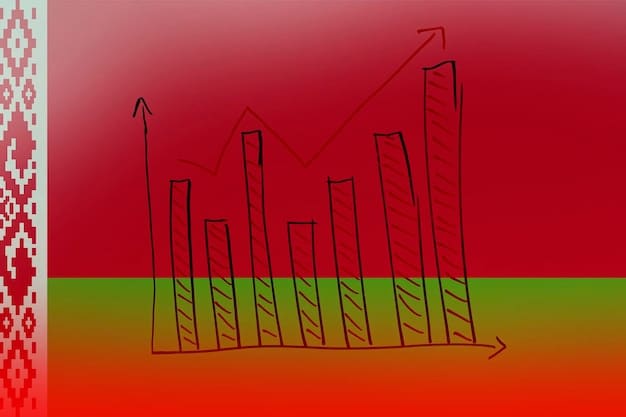Evaluating Income Inequality Policies: A US Perspective

Evaluating the effectiveness of current policies aimed at reducing income inequality in the US involves analyzing their impact on income distribution, economic growth, and social welfare, considering factors like tax structures, education access, and labor market dynamics.
Evaluating the effectiveness of current policies aimed at reducing income inequality in the United States is a critical task. The growing gap between the rich and the poor has significant implications for social cohesion and economic stability, making it imperative to understand whether existing measures are truly making a difference.
Understanding Income Inequality in the US
Income inequality in the United States has been a persistent and growing concern. The gap between the highest and lowest earners has widened considerably over the past few decades, leading to numerous social and economic challenges.
Historical Trends
Over the last half-century, the US has experienced a significant shift in income distribution. The post-World War II era saw a relatively equitable distribution of wealth, but this trend began to reverse in the 1970s.
- The top 1% of earners have seen their incomes grow exponentially, while the incomes of the bottom 90% have stagnated.
- Technological advancements and globalization have contributed to the shift, favoring highly skilled workers and capital owners.
- Changes in tax policies, such as reductions in top marginal tax rates and capital gains taxes, have also played a role.
These historical trends underscore the need to evaluate current policies aimed at addressing income inequality and ensuring a fairer distribution of wealth.

Current Policies in Place
The US employs a variety of policies designed to mitigate income inequality. These range from progressive taxation to social welfare programs aimed at supporting lower-income households.
Many of these policies include programs that ensure access to resources for the less privileged, guaranteeing a standard of living, as well as aiming for social and financial inclusion.
Progressive Taxation
One of the primary tools for addressing income inequality is progressive taxation, where higher earners pay a larger percentage of their income in taxes. The US federal income tax system is designed to be progressive, with marginal tax rates increasing with income.
However, the effectiveness of progressive taxation in reducing income inequality has been debated, particularly in light of tax policy changes over the years.
Social Welfare Programs
The US also has a range of social welfare programs aimed at supporting low-income individuals and families. These programs provide essential resources and services to those in need.
- Supplemental Nutrition Assistance Program (SNAP): Provides food assistance to low-income households.
- Medicaid: Offers healthcare coverage to low-income individuals and families.
- Earned Income Tax Credit (EITC): Provides a tax credit to low- and moderate-income working individuals and couples, particularly those with children.
Evaluating the impact of these programs on income inequality requires assessing their reach, adequacy, and overall effectiveness in improving the economic well-being of vulnerable populations.
Ultimately, these policies represent efforts to balance economic growth with social equity.
Evaluating the Effectiveness of Tax Policies
Assessing how well different tax policies work in reducing income inequality involves looking at their effects on how income is distributed, how the economy grows, and the overall well-being of society.
Tax policies can either help close the income gap or, unintentionally, make it wider.
Impact on Income Distribution
Tax policies can significantly influence the distribution of income. Progressive tax systems, where higher earners pay a larger percentage of their income in taxes, are designed to reduce income inequality.
However, the actual impact depends on various factors, including the specific tax rates, deductions, and loopholes in the tax code.
Economic Growth
The relationship between tax policies and economic growth is complex and often debated. Some argue that high tax rates on top earners can discourage investment and entrepreneurship, thereby hindering economic growth.
Others contend that progressive taxation can fund public goods and services, such as education and infrastructure, which can boost long-term economic growth.
Case Studies
Examining case studies of countries with different tax policies can provide valuable insights. For example, countries with more progressive tax systems, such as Scandinavian nations, often have lower levels of income inequality.
These studies may give some clues as to the potential effect of tax policies over the long term.
The importance of tax policy cannot be overstated.
Assessing Social Welfare Programs
Social welfare programs form a critical component of efforts to reduce income inequality. These programs aim to provide a safety net for low-income individuals and families, ensuring access to essential resources and services.
The programs that are most effective tend to consider the needs of specific demographics within a population, and create strategies to attend to those individuals.
Impact on Poverty Reduction
One of the primary goals of social welfare programs is to reduce poverty. Programs like SNAP, Medicaid, and EITC have been shown to lift millions of people out of poverty each year.
- SNAP provides crucial food assistance, reducing hunger and food insecurity among low-income households.
- Medicaid ensures access to healthcare, improving health outcomes and reducing medical debt.
- EITC incentivizes work and provides a financial boost to low- and moderate-income workers.
These programs play a vital role in alleviating poverty and improving the economic well-being of vulnerable populations.
Long-Term Effects
In addition to immediate poverty reduction, social welfare programs can have long-term effects on individuals and families. Access to healthcare, nutrition, and education can improve human capital development and increase future earnings potential.
For example, studies have shown that children who receive nutritional assistance through programs like WIC (Women, Infants, and Children) have better cognitive development and educational outcomes.
Challenges and Limitations
Despite their benefits, social welfare programs also face challenges and limitations. These include:
- Inadequate funding, limiting the reach and adequacy of benefits.
- Administrative complexities, making it difficult for eligible individuals to access services.
- Stigma associated with receiving public assistance, discouraging some individuals from participating.
Addressing these challenges is essential to maximizing the effectiveness of social welfare programs in reducing income inequality.
The Role of Education and Skills Training
Education and skills training are vital tools for promoting economic mobility and reducing income inequality. Improving access to quality education and providing opportunities for skills development can help individuals climb the economic ladder.
These efforts must accommodate changing work styles and evolving technology.
Access to Quality Education
Ensuring that all individuals have access to quality education, regardless of their socioeconomic background, is crucial. This includes:
- Investing in early childhood education programs, such as Head Start, to provide a strong foundation for future learning.
- Improving the quality of K-12 education, particularly in low-income communities.
- Making higher education more affordable through scholarships, grants, and loan forgiveness programs.
By investing in education, the US can create a more level playing field and provide opportunities for individuals to acquire the skills and knowledge needed to succeed in the modern economy.
Skills Training Programs
In addition to formal education, skills training programs play a critical role in preparing individuals for in-demand jobs. These programs can provide individuals with the specific skills and certifications needed to enter or advance in high-growth industries.
When it comes to skills training, there are a variety of options, including vocational schools, community colleges, companies or even local government.
Addressing Skills Gaps
One of the key challenges in addressing income inequality is bridging the skills gap. Many individuals lack the skills and training needed to compete for high-paying jobs in today’s economy.
By investing in education and skills training, the US can equip individuals with the tools they need to succeed and reduce income inequality.

Alternative Approaches and Policy Innovations
In addition to traditional policies, a number of alternative approaches and policy innovations have been proposed to address income inequality. These include:
Considering a multipronged approach is crucial for creating lasting change.
Universal Basic Income (UBI)
Universal Basic Income (UBI) is a policy proposal that would provide all citizens with a regular, unconditional cash payment. Proponents argue that UBI could provide a safety net for low-income individuals and reduce poverty.
Critics, however, raise concerns about the cost and potential disincentive to work.
Wealth Tax
A wealth tax is a tax on an individual’s total net worth, including assets such as stocks, bonds, and real estate. Proponents argue that a wealth tax could help reduce wealth concentration and generate revenue for public services.
Strengthening Labor Unions
Labor unions can play a critical role in promoting fair wages and working conditions. By strengthening labor unions and collective bargaining rights, it may be possible to increase worker power and reduce income inequality.
New legislation may be needed in some states to ensure these efforts are successful.
By exploring alternative approaches and policy innovations, the US can develop more effective and comprehensive solutions to address income inequality.
In conclusion, the need for immediate action is clear.
| Key Point | Brief Description |
|---|---|
| 📊 Progressive Taxation | Higher earners pay a larger percentage of their income in taxes. |
| 🍎 Social Welfare Programs | SNAP, Medicaid, and EITC support low-income individuals and families. |
| 🎓 Education & Skills Training | Improving access to quality education and skills development. |
| 💰 Universal Basic Income | Providing all citizens with a regular, unconditional income. |
Frequently Asked Questions
▼
Income inequality refers to the extent to which income is distributed unevenly among a population. High levels of income inequality mean that a small percentage of the population controls a large share of the total income.
▼
Income inequality is a concern because it can lead to social unrest, reduced economic mobility, and poorer health outcomes. It can also undermine democracy and social cohesion, impacting overall quality of life.
▼
Policies to reduce income inequality include progressive taxation, social welfare programs (like SNAP and Medicaid), education and skills training, UBI, wealth taxes, and strengthening labor unions.
▼
The effectiveness of current policies varies. Some have shown success in reducing poverty, while others have had limited impact. Continuous evaluation and adaptation are necessary to improve outcomes and effectiveness.
▼
Universal Basic Income (UBI) is a policy proposal to provide all citizens with a regular, unconditional cash payment. It aims to ensure a basic standard of living and reduce poverty, but its effectiveness is still debated.
Conclusion
Evaluating policies aimed at reducing income inequality in the US reveals the need for continuous assessment and adaptive strategies. By combining progressive taxation, robust social welfare programs, and investments in education and skills training, the US can move towards a more equitable society. Exploring alternative approaches like UBI and wealth taxes may offer additional avenues for reducing inequality and promoting economic mobility for all.





